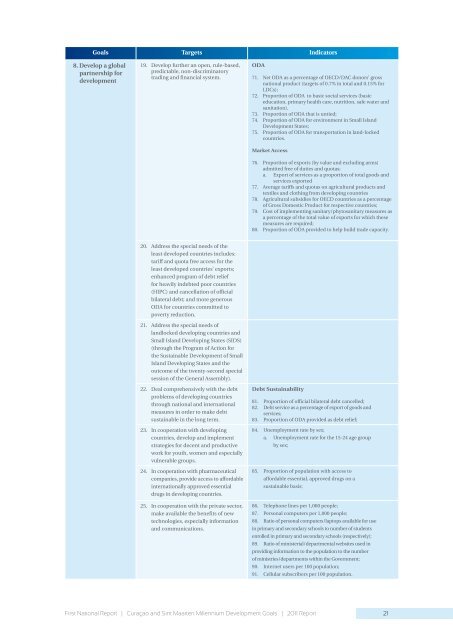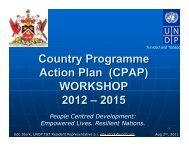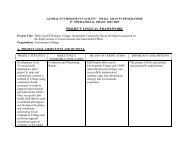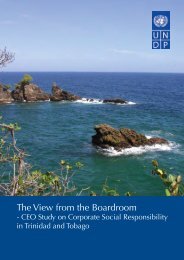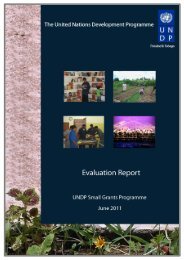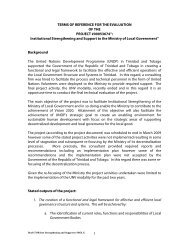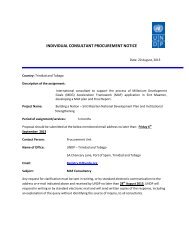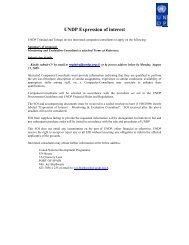Curaçao & Sint Maarten - UNDP Trinidad and Tobago
Curaçao & Sint Maarten - UNDP Trinidad and Tobago
Curaçao & Sint Maarten - UNDP Trinidad and Tobago
Create successful ePaper yourself
Turn your PDF publications into a flip-book with our unique Google optimized e-Paper software.
Goals Targets Indicators<br />
8. Develop a global<br />
partnership for<br />
development<br />
19. Develop further an open, rule-based,<br />
predictable, non-discriminatory<br />
trading <strong>and</strong> financial system.<br />
20. Address the special needs of the<br />
least developed countries includes:<br />
tariff <strong>and</strong> quota free access for the<br />
least developed countries’ exports;<br />
enhanced program of debt relief<br />
for heavily indebted poor countries<br />
(HIPC) <strong>and</strong> cancellation of official<br />
bilateral debt; <strong>and</strong> more generous<br />
ODA for countries committed to<br />
poverty reduction.<br />
21. Address the special needs of<br />
l<strong>and</strong>locked developing countries <strong>and</strong><br />
Small Isl<strong>and</strong> Developing States (SIDS)<br />
(through the Program of Action for<br />
the Sustainable Development of Small<br />
Isl<strong>and</strong> Developing States <strong>and</strong> the<br />
outcome of the twenty-second special<br />
session of the General Assembly).<br />
22. Deal comprehensively with the debt<br />
problems of developing countries<br />
through national <strong>and</strong> international<br />
measures in order to make debt<br />
sustainable in the long term.<br />
23. In cooperation with developing<br />
countries, develop <strong>and</strong> implement<br />
strategies for decent <strong>and</strong> productive<br />
work for youth, women <strong>and</strong> especially<br />
vulnerable groups.<br />
24. In cooperation with pharmaceutical<br />
companies, provide access to affordable<br />
internationally approved essential<br />
drugs in developing countries.<br />
25. In cooperation with the private sector,<br />
make available the benefits of new<br />
technologies, especially information<br />
<strong>and</strong> communications.<br />
ODA<br />
First National Report | <strong>Curaçao</strong> <strong>and</strong> <strong>Sint</strong> <strong>Maarten</strong> Millennium Development Goals | 2011 Report<br />
71. Net ODA as a percentage of OECD/DAC donors’ gross<br />
national product (targets of 0.7% in total <strong>and</strong> 0.15% for<br />
LDCs);<br />
72. Proportion of ODA to basic social services (basic<br />
education, primary health care, nutrition, safe water <strong>and</strong><br />
sanitation).<br />
73. Proportion of ODA that is untied;<br />
74. Proportion of ODA for environment in Small Isl<strong>and</strong><br />
Development States;<br />
75. Proportion of ODA for transportation in l<strong>and</strong>-locked<br />
countries.<br />
Market Access<br />
76. Proportion of exports (by value <strong>and</strong> excluding arms)<br />
admitted free of duties <strong>and</strong> quotas;<br />
a. Export of services as a proportion of total goods <strong>and</strong><br />
services exported<br />
77. Average tariffs <strong>and</strong> quotas on agricultural products <strong>and</strong><br />
textiles <strong>and</strong> clothing from developing countries<br />
78. Agricultural subsidies for OECD countries as a percentage<br />
of Gross Domestic Product for respective countries;<br />
79. Cost of implementing sanitary/phytosanitary measures as<br />
a percentage of the total value of exports for which these<br />
measures are required;<br />
80. Proportion of ODA provided to help build trade capacity.<br />
Debt Sustainability<br />
81. Proportion of official bilateral debt cancelled;<br />
82. Debt service as a percentage of export of goods <strong>and</strong><br />
services;<br />
83. Proportion of ODA provided as debt relief;<br />
84. Unemployment rate by sex;<br />
a. Unemployment rate for the 15-24 age group<br />
by sex;<br />
85. Proportion of population with access to<br />
affordable essential, approved drugs on a<br />
sustainable basis;<br />
86. Telephone lines per 1,000 people;<br />
87. Personal computers per 1,000 people;<br />
88. Ratio of personal computers/laptops available for use<br />
in primary <strong>and</strong> secondary schools to number of students<br />
enrolled in primary <strong>and</strong> secondary schools (respectively);<br />
89. Ratio of ministerial/departmental websites used in<br />
providing information to the population to the number<br />
of ministries/departments within the Government;<br />
90. Internet users per 100 population;<br />
91. Cellular subscribers per 100 population.<br />
21


